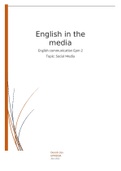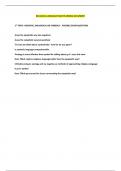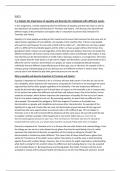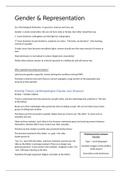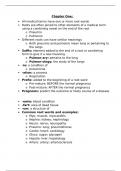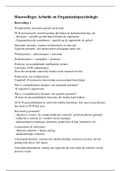Introduction to Science
& Business
Lecture 1 – Introduction science & business – 06-09-2021
Science advising = practical connection between the domain of science and the societal domains of
business and policy, in the context of innovation.
Nine demands for successful science advising:
1. Keep an open mind and eye for different interests.
2. Supply input from your field of science, based on actual knowledge and approaches.
3. Understand the language of other
disciplines.
4. Acquire support; comply or explain.
5. Stay critical; maintain an academic
level.
6. Synchronize advice with internal and
external temporal constraints.
7. Convince in argumentation and presentation.
8. Build bridges; show commitment but stay independent.
9. Deal with wishes; do not accept dictates.
Plane of professions:
SBP innovation loop model:
Looking back, evaluation. There is a
question and in the end you have an
advice. There is a domain where the
science and business is. You look into
societal domain to determine how to
answer questions and what kind of
science you can do to help you out.
Problem look what company wants
and look if this is an answer. Determine
1
,the resources and what do you need. Then you are finding out how you can do this. So strategic
choices and then there is an advice.
Empirical cycle:
You start with an observation idea in how to do something
(hypothesis) predictions test evaluate and then you
observe the evaluation and compare with observation maybe
cycle again.
Solving problem:
From problem to solution green is what you need to solve.
Somewhere in the problem there is a problem. How to bypass this
problem?
Do something different then you can go on.
Stop the project no subsequent steps. We don’t have all the
science etc to carry out every different project.
Take multiple steps to bypass your problem.
Find different solution few steps back.
Business analysis:
SWOT
o Strengths internal analysis, positive
o Weakness internal analysis, negative
o Opportunities external analysis, positive
o Threats external analysis, negative
Combine different analysis come up with SWOT analysis.
All arguments should be summarized. SWOT used to match
strengths and opportunities. Weakness and threats should be
conversed or minimized. If negative aspects cannot be avoided, one should consider bypasses.
Strategic cycle:
Develop mission, aims and strategy. As a starting project,
you need to figure out what you want to achieve and then
you follow the strategic cycle.
Initial idea/technical development advice formulation
based on analysis of demand and resources express
preference for strategic options for feasible design
positive strategic decision implementation program
financial support production or policy implementation
evaluation.
Strategy is dynamic, it is always changing because
environment is always changing. It needs adjustments.
Science involves uncertainties, both in quality of data and causality, related to theoretical
disagreements on a theoretical basis. Reveal testable, universal, and objective.
Business different, since they are based on demonstratable and profitable consumer acceptance.
Policy aims to achieve societal goals, supported and legitimated by political appreciation.
Business model:
What is the business model, it is something: how are you
carry out your plan. What are you going to do, so this is
your value proposition. Then it is important to who you
are going to sell this: customer segment, customer
2
,relationship, distribution. If you now what and whom. Then you have to think: how to put this in
practice? Activities, resources, partners and then you have to think: how to earn money from this?
Cost structure & revenue streams.
Stakeholders:
Stakeholders are people who are involved in your project. You have
to remember that you do a project as a business person.
Stakeholders, you have to manage with communicating with them.
Look how your stakeholder perform and how you need to inform
them.
Stakeholders can be arranged according to two characteristics:
interest in development of the innovation and their power.
Natural Person is a single person company where the business risk is
on the personal wealth. A Legal Entity is a company where the risk is limited to the wealth that has
been put into the company. A Legal Entity can be one person company.
To judge the legal and financial and legal credibility of a future partner it is essential to know in which
legal context business this partner operates.
Science-based advising:
Think and act like a business manager and not like a consumer.
The practical connection of science and the societal domains of business and policy, in the
context of innovation.
Science-based advising will be most effective if it can take place from an independent
perspective, connected with, but not depending on, wishes from both science institutions
and commercial or (non)governmental institutions.
Successful science advising:
Have an open mind and eye for the different “interests”.
Supply input from your field of science based on actual knowledge and approaches.
Understand the language of other disciplines.
Acquire support: comply or explain.
Stay critical, guard an academic level.
Synchronize the advice with internal and external temporal constraints.
Convince in argumentation and
presentation.
Build bridges, show commitment but stay
independent (deal with wishes, do not
accept dictates).
SBP loop model of innovation advice:
In different phases of the loop model, the balance
between the two opposite domains of science and
technology and society can vary.
Two aspects in problem definition phase require
extra emphasis:
1. Innovation process should strive for a
mode in which all relevant stakeholders
have similar understandings of a problem’s
basic concepts.
2. There should be room for conceptual thinking.
3
, Demand analysis is the next phase of the innovation loop model and involves examining the external
aspects of an innovation. PESTEL analysis:
Political context (P)
Macro-economic (E)
Social trends (S)
Technological climate (T)
Environmental conditions (E)
Legal aspects (L)
Micro-economic analysis = conducted at the level of a business. This may assess the power of buyers
or suppliers, the danger of existing or new competitors.
Stakeholder power-interest matrices, PESTEL analyses and SWOT analyses have been introduced as
examples of general tools for use in subsequent phases of innovation (problem definition, demand
and resource analyses and strategic choices).
Lecture 2 – R&D (research & development)/Technology – 07-09-
2021
Suppose you are an advisor of a large pharmaceutical company and the CEO ask you to list all
relevant requirements of a new vaccine, which make it ready for introduction. What are these
requirements:
Effective and reliable.
Side effects (safety).
Understand basic mechanisms.
Is it affordable?
Is it acceptable for all types of citizens?
Is it easy to apply in different situations?
Can it be produced and distributed on a large scale?
Can it be integrated in existing health system?
Technological innovation
What is technology: applied science?
Yes: science based, rational, mission and solution oriented.
But: technology is more: specific knowledge on scaling, implementation and design to
develop technology.
Technological innovation, but also non technological innovation and with
technological innovation we can divide it into product innovation and process
innovation. Innovation is a new idea, device, method (application or solution).
Innovation = new idea or method that is introduced in the way that something
is done or made.
Related terms:
Research & development (R&D): mission or product oriented science and technology, may
include design.
Research and development is sometimes related to new products, but also departments of
companies is doing me2 research and that is a copy of what is already on the market.
Design: aesthetic ergonomic aspects.
Engineering: application of knowledge to make materials, processes and organizations.
4
& Business
Lecture 1 – Introduction science & business – 06-09-2021
Science advising = practical connection between the domain of science and the societal domains of
business and policy, in the context of innovation.
Nine demands for successful science advising:
1. Keep an open mind and eye for different interests.
2. Supply input from your field of science, based on actual knowledge and approaches.
3. Understand the language of other
disciplines.
4. Acquire support; comply or explain.
5. Stay critical; maintain an academic
level.
6. Synchronize advice with internal and
external temporal constraints.
7. Convince in argumentation and presentation.
8. Build bridges; show commitment but stay independent.
9. Deal with wishes; do not accept dictates.
Plane of professions:
SBP innovation loop model:
Looking back, evaluation. There is a
question and in the end you have an
advice. There is a domain where the
science and business is. You look into
societal domain to determine how to
answer questions and what kind of
science you can do to help you out.
Problem look what company wants
and look if this is an answer. Determine
1
,the resources and what do you need. Then you are finding out how you can do this. So strategic
choices and then there is an advice.
Empirical cycle:
You start with an observation idea in how to do something
(hypothesis) predictions test evaluate and then you
observe the evaluation and compare with observation maybe
cycle again.
Solving problem:
From problem to solution green is what you need to solve.
Somewhere in the problem there is a problem. How to bypass this
problem?
Do something different then you can go on.
Stop the project no subsequent steps. We don’t have all the
science etc to carry out every different project.
Take multiple steps to bypass your problem.
Find different solution few steps back.
Business analysis:
SWOT
o Strengths internal analysis, positive
o Weakness internal analysis, negative
o Opportunities external analysis, positive
o Threats external analysis, negative
Combine different analysis come up with SWOT analysis.
All arguments should be summarized. SWOT used to match
strengths and opportunities. Weakness and threats should be
conversed or minimized. If negative aspects cannot be avoided, one should consider bypasses.
Strategic cycle:
Develop mission, aims and strategy. As a starting project,
you need to figure out what you want to achieve and then
you follow the strategic cycle.
Initial idea/technical development advice formulation
based on analysis of demand and resources express
preference for strategic options for feasible design
positive strategic decision implementation program
financial support production or policy implementation
evaluation.
Strategy is dynamic, it is always changing because
environment is always changing. It needs adjustments.
Science involves uncertainties, both in quality of data and causality, related to theoretical
disagreements on a theoretical basis. Reveal testable, universal, and objective.
Business different, since they are based on demonstratable and profitable consumer acceptance.
Policy aims to achieve societal goals, supported and legitimated by political appreciation.
Business model:
What is the business model, it is something: how are you
carry out your plan. What are you going to do, so this is
your value proposition. Then it is important to who you
are going to sell this: customer segment, customer
2
,relationship, distribution. If you now what and whom. Then you have to think: how to put this in
practice? Activities, resources, partners and then you have to think: how to earn money from this?
Cost structure & revenue streams.
Stakeholders:
Stakeholders are people who are involved in your project. You have
to remember that you do a project as a business person.
Stakeholders, you have to manage with communicating with them.
Look how your stakeholder perform and how you need to inform
them.
Stakeholders can be arranged according to two characteristics:
interest in development of the innovation and their power.
Natural Person is a single person company where the business risk is
on the personal wealth. A Legal Entity is a company where the risk is limited to the wealth that has
been put into the company. A Legal Entity can be one person company.
To judge the legal and financial and legal credibility of a future partner it is essential to know in which
legal context business this partner operates.
Science-based advising:
Think and act like a business manager and not like a consumer.
The practical connection of science and the societal domains of business and policy, in the
context of innovation.
Science-based advising will be most effective if it can take place from an independent
perspective, connected with, but not depending on, wishes from both science institutions
and commercial or (non)governmental institutions.
Successful science advising:
Have an open mind and eye for the different “interests”.
Supply input from your field of science based on actual knowledge and approaches.
Understand the language of other disciplines.
Acquire support: comply or explain.
Stay critical, guard an academic level.
Synchronize the advice with internal and external temporal constraints.
Convince in argumentation and
presentation.
Build bridges, show commitment but stay
independent (deal with wishes, do not
accept dictates).
SBP loop model of innovation advice:
In different phases of the loop model, the balance
between the two opposite domains of science and
technology and society can vary.
Two aspects in problem definition phase require
extra emphasis:
1. Innovation process should strive for a
mode in which all relevant stakeholders
have similar understandings of a problem’s
basic concepts.
2. There should be room for conceptual thinking.
3
, Demand analysis is the next phase of the innovation loop model and involves examining the external
aspects of an innovation. PESTEL analysis:
Political context (P)
Macro-economic (E)
Social trends (S)
Technological climate (T)
Environmental conditions (E)
Legal aspects (L)
Micro-economic analysis = conducted at the level of a business. This may assess the power of buyers
or suppliers, the danger of existing or new competitors.
Stakeholder power-interest matrices, PESTEL analyses and SWOT analyses have been introduced as
examples of general tools for use in subsequent phases of innovation (problem definition, demand
and resource analyses and strategic choices).
Lecture 2 – R&D (research & development)/Technology – 07-09-
2021
Suppose you are an advisor of a large pharmaceutical company and the CEO ask you to list all
relevant requirements of a new vaccine, which make it ready for introduction. What are these
requirements:
Effective and reliable.
Side effects (safety).
Understand basic mechanisms.
Is it affordable?
Is it acceptable for all types of citizens?
Is it easy to apply in different situations?
Can it be produced and distributed on a large scale?
Can it be integrated in existing health system?
Technological innovation
What is technology: applied science?
Yes: science based, rational, mission and solution oriented.
But: technology is more: specific knowledge on scaling, implementation and design to
develop technology.
Technological innovation, but also non technological innovation and with
technological innovation we can divide it into product innovation and process
innovation. Innovation is a new idea, device, method (application or solution).
Innovation = new idea or method that is introduced in the way that something
is done or made.
Related terms:
Research & development (R&D): mission or product oriented science and technology, may
include design.
Research and development is sometimes related to new products, but also departments of
companies is doing me2 research and that is a copy of what is already on the market.
Design: aesthetic ergonomic aspects.
Engineering: application of knowledge to make materials, processes and organizations.
4

